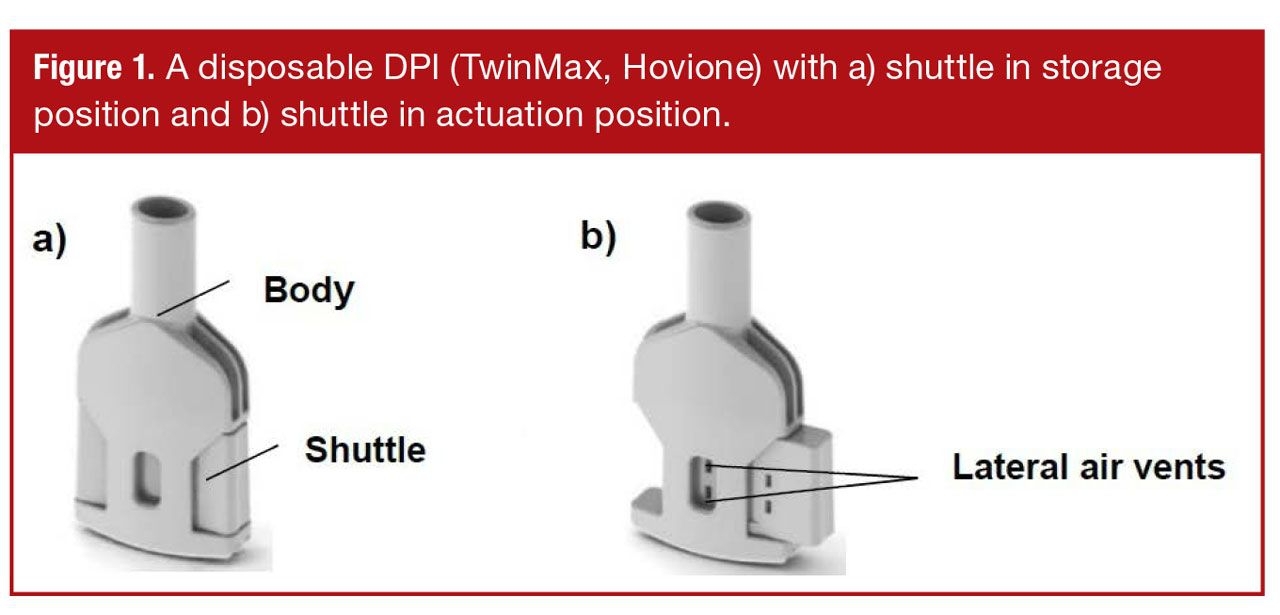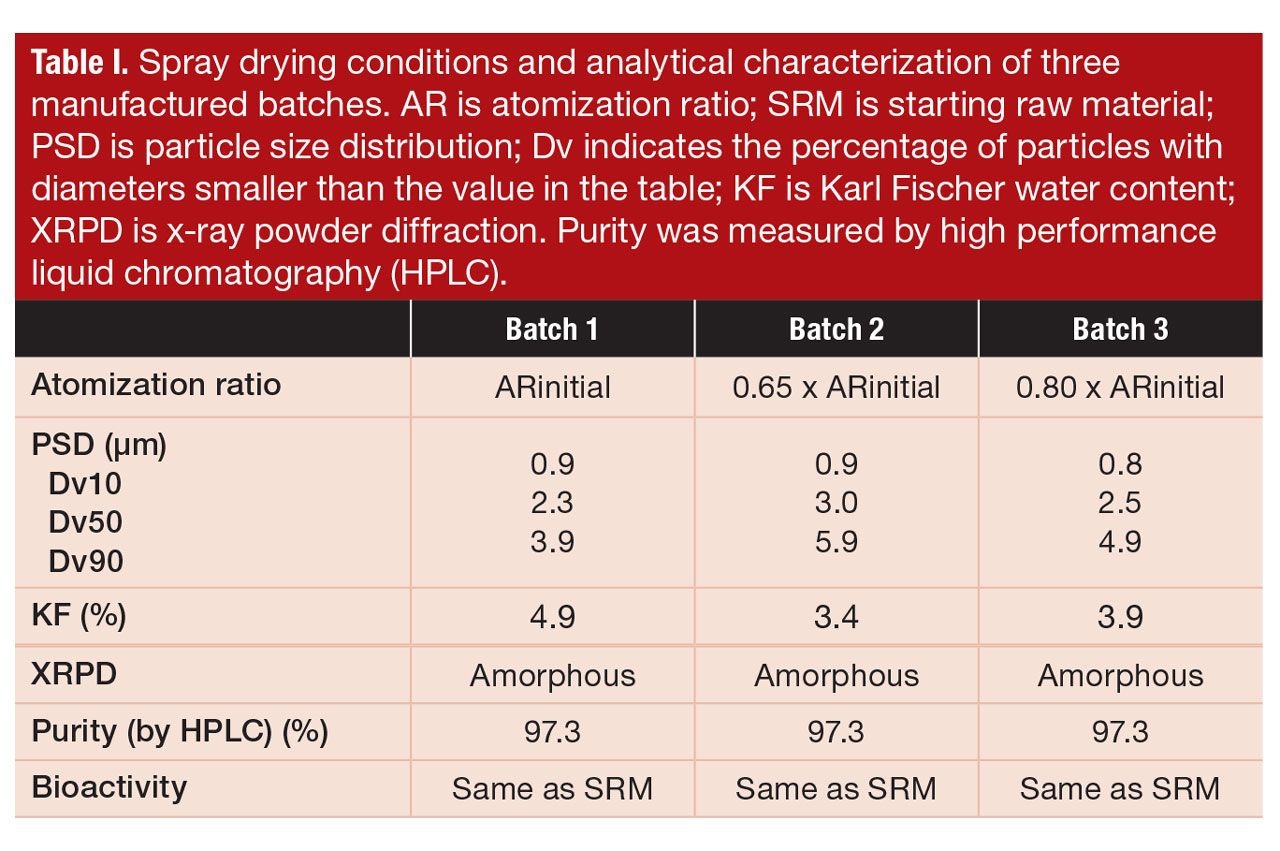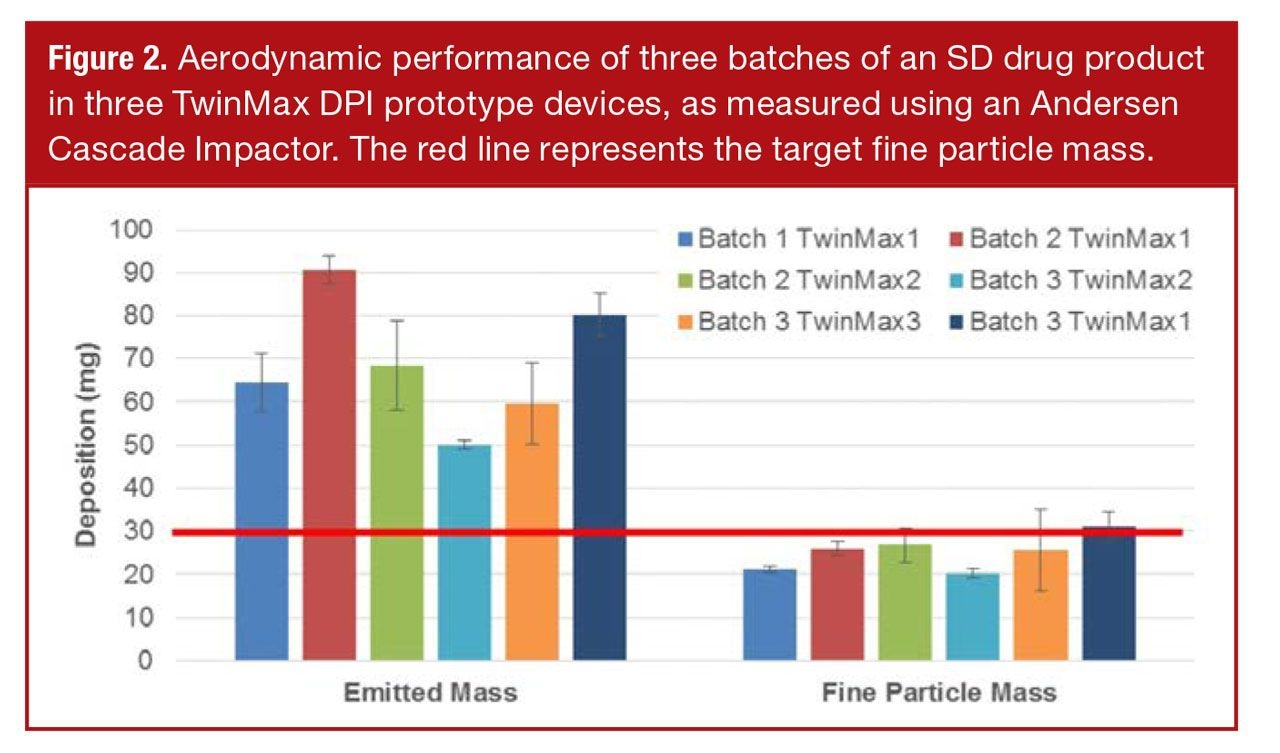Knowledge Center
Spray Drying as an Enabling Technology for Inhalation Drug Delivery
A carrier-based formulation strategy is well known by the inhalation community. Novel formulation requirements, such as the delivery of poorly water-soluble compounds, biomolecules, and high dosages to the lungs, however, are not easily met by the conventional strategy. As a consequence, spray-drying has gained interest as an enabling technology for inhalation drug delivery, culminating in an increasing number of products on the market.
In this article, the use of spray-drying as a platform for tailored dry powder inhaler (DPI) formulation in combination with disposable devices will be explored, for amorphous composite particles with enhanced characteristics and performance, for a diverse range of doses and applications. The main advantages of this manufacturing process for inhalation drug delivery will be discussed in detail as well as the manufacturing challenges and critical process parameters to take into consideration when developing a spray-dried DPI, from particle engineering to device filling.
Pulmonary delivery is a well-researched, non-invasive method for local and systemic drug delivery of APIs. The lungs have unique features, such as large surface area, thin alveolar capillary membrane, low enzymatic activity, and absence of first-pass metabolism, making this route of administration attractive for drug delivery (1). Although there are three major strategies to succeed in delivering drugs to the lung (nebulizers, metered-dose inhalers, and dry powder inhalers [DPIs]), DPIs allow for an immediate delivery without propellants.
DPIs are a combination of device and dry powder capable of delivering, upon patient breathing, APIs to the lung surface. To accomplish this delivery, the device must ensure efficient particle aerosolization, and the formulation should have suitable aerodynamic properties. Amongst DPIs, carrier-based formulations are the most well-known and established. These formulations comprise a physical mixture of large carrier particles and micronized API with optimized size and morphology (2). Fine particles of excipients might be added to these mixtures to improve the aerodynamic performance of the drug product.
Carrier-based formulation challenges
Carrier-based drug products present some advantages, namely improved stability as a result of the dry crystalline state and a robust manufacturing process. These formulations, however, have some drawbacks, such as an inefficient drug deposition in the deep lung; in fact, it is estimated that only 10–15% of the drug administered reaches the deep lung, as about 20% of the drug administered is lost in the oropharyngeal tract and the remaining percentage is not released from the carrier (2, 3). Delivery efficiency is especially hindered on the delivery of higher dosages; as the drug load in the blend increases, the aerodynamic performance decreases, proportionally (4). Another limitation of these formulations is the inability to act as a solubility enhancer for poorly water-soluble compounds; it is not the main purpose of carrier-based formulations to modify or improve the surface of the API and consequently, its dissolution rate. Lastly, carrier-based formulations require a micronization step, which makes its applicability to sensitive compounds, such as biopharmaceuticals, challenging. The molecular weight of biologic molecules under development for inhalation ranges from a few kDa to about 50 kDa. Larger molecules present increased difficulties when developing a formulation for inhalation, given the increased likelihood of chemical and physical stability challenges (5).
In this article, the use of spray-drying as a platform for tailored dry powder inhaler (DPI) formulation in combination with disposable devices will be explored, for amorphous composite particles with enhanced characteristics and performance, for a diverse range of doses and applications. The main advantages of this manufacturing process for inhalation drug delivery will be discussed in detail as well as the manufacturing challenges and critical process parameters to take into consideration when developing a spray-dried DPI, from particle engineering to device filling.
Pulmonary delivery is a well-researched, non-invasive method for local and systemic drug delivery of APIs. The lungs have unique features, such as large surface area, thin alveolar capillary membrane, low enzymatic activity, and absence of first-pass metabolism, making this route of administration attractive for drug delivery (1). Although there are three major strategies to succeed in delivering drugs to the lung (nebulizers, metered-dose inhalers, and dry powder inhalers [DPIs]), DPIs allow for an immediate delivery without propellants.
DPIs are a combination of device and dry powder capable of delivering, upon patient breathing, APIs to the lung surface. To accomplish this delivery, the device must ensure efficient particle aerosolization, and the formulation should have suitable aerodynamic properties. Amongst DPIs, carrier-based formulations are the most well-known and established. These formulations comprise a physical mixture of large carrier particles and micronized API with optimized size and morphology (2). Fine particles of excipients might be added to these mixtures to improve the aerodynamic performance of the drug product.
Carrier-based formulation challenges
Carrier-based drug products present some advantages, namely improved stability as a result of the dry crystalline state and a robust manufacturing process. These formulations, however, have some drawbacks, such as an inefficient drug deposition in the deep lung; in fact, it is estimated that only 10–15% of the drug administered reaches the deep lung, as about 20% of the drug administered is lost in the oropharyngeal tract and the remaining percentage is not released from the carrier (2, 3). Delivery efficiency is especially hindered on the delivery of higher dosages; as the drug load in the blend increases, the aerodynamic performance decreases, proportionally (4). Another limitation of these formulations is the inability to act as a solubility enhancer for poorly water-soluble compounds; it is not the main purpose of carrier-based formulations to modify or improve the surface of the API and consequently, its dissolution rate. Lastly, carrier-based formulations require a micronization step, which makes its applicability to sensitive compounds, such as biopharmaceuticals, challenging. The molecular weight of biologic molecules under development for inhalation ranges from a few kDa to about 50 kDa. Larger molecules present increased difficulties when developing a formulation for inhalation, given the increased likelihood of chemical and physical stability challenges (5).
Role of particle engineering
A new formulation strategy reveals a promising and innovative way of increasing the pulmonary deposition of drugs. Spray drying (SD) is the gold standard particle engineering technology usually employed in the manufacturing of engineered particles in which the API is alone or embedded within an excipient matrix (6). SD enables the production of inhalable powders with increased control over particle size, morphology, and density by fine-tuning formulation composition and process parameters.
Particle engineered formulations produced by SD have an optimized aerodynamic performance, leading to an increased fine particle fraction (FPF), meaning a higher delivery to the deep lungs. The optimized performance of carrier-free particles is due to the intentional particle design, as well as better powder uniformity and aerosolization (3). Particle design upon SD is achieved by the association of ingredients with different roles within the same power, and by adjusting the SD process parameters, leading to different particle morphologies and interactions. As a consequence, the SD technology enables a reduction of the API concentration in the formulation while maintaining the amount delivered to the target (7). Additionally, amorphous solid dispersions manufactured by SD are extensively used for solubility enhancement for other delivery routes and have shown similar results on pulmonary delivery (8). Another SD application is the stabilization and effective pulmonary delivery of biopharmaceuticals within composite engineered particles, while preventing product denaturation at high temperatures due to the flash-drying phenomenon (5).
Challenges during composite particles development
In spray drying, both a feed solution and suspension can be processed. The feed is atomized in a nozzle into a fine spray which is typically flash dried by a co-current stream of hot nitrogen. The particles, once formed, are collected in cyclones and/or bag filters and the drying gas recycled after condensing the removed solvent.
There are a limited number of excipients suitable for lung delivery, and excipient choice is driven by stabilization of the API, which translates into stabilizing the amorphous form of an API or decreasing the mobility of a biomolecules, improvement of formulation dispersibility by adding a shell former to maximize aerodynamic performance, and, if required, permeability enhancement by adding a lipid for instance (3). Consequently, to take advantage of the SD technology during the preparation of composite particles for inhalation, it is mandatory to perform adequate excipient selection (9).
The SD technique enables the production of inhalable particles with controlled particle size, water content, morphology, and density by tuning not only the formulation composition, but also the process parameters. There are several phenomena to take into consideration in the SD process: the atomization that is key for determining the droplet size and later on the particle size; the particle formation, with the process drying kinetics impacting particle size and morphology; the overall fluid dynamics across the equipment, dictating drying efficiencies and overall yields on the collector, as well as the overall process (3,8). Adequate process development and adjustment of process parameters allow a tight control in the powder characteristics and an improvement of powder uniformity, dispersibility and, consequently, aerosolization behavior. This process development ultimately results in a drug product with an augmented delivered dose to the lungs, without increasing the emitted dose, which benefits the overall safety of the drug product with a reduction in the adverse side effects experienced by patients with respiratory diseases. Furthermore, from the manufacturer’s point of view, SD technology represents an easy to operate, flexible, readily scalable, and time-effective technology (9).
Case study
As a case study, consider the DPI development of a synthetic peptide AP301 (Solnatide) designed to activate the epithelial sodium channel (ENaC) of type II alveolar cells of lungs. Solnatide requires a high dosage delivery to clear pulmonary edema arising, for example, from high altitude exposure, blood transfusions, or lung infections (e.g., pneumonia and influenza) (10).
The SD process development targeted a drug-alone product (i.e., free of additional excipients) suitable for lung delivery. The goal was to obtain different particle size distributions (PSD) aiming to reduce the adhesive/cohesive forces that are typically present in composite particles.
A disposable, prefilled device (TwinMax, Hovione), which was designed to handle high dosage delivery of challenging powders, was used (see Figure 1). Three device prototypes were studied, with the aim of maximizing the dispersive forces and powder deagglomeration. A prefilled device (as opposed to a capsule-based DPI) is an advantage for rescue/emergency treatments. Since the device is prefilled, the cohesive/adhesive balance must be fine-tuned and optimized to have lower adhesion to the device as well as lower attachment to the coarse lactose, aiming for an increased fine particle mass (FPM).

The engineered particles were manufactured using a Büchi unit model B-290 Advanced, by spraying a solution of the API (AP301) in water. The atomization ratio was optimized to refine the PSD and to optimize the cohesive-adhesive balance between particles and devices’ surface (see Table I).
The results in Table I show that the manipulation of the ratio of atomization allowed a fine control of the PSD (with all Dv50 values comprised between 2 and 3 μm). All powders were found to be amorphous, with a very high purity and a low water content (KF

The batches obtained were characterized in terms of their aerodynamic performance using an Andersen Cascade Impactor, with TwinMax prototypes operating at ~40 L/min for 4 kPa. The parameters analyzed were emitted mass (EM) (mg) and FPM (mg). A total of three replicates were carried out to characterize the selected combinations of powder and device shown in Figure 2.

The results reveal that the strategy of improving the aerodynamic performance through particle size manipulation was fruitful. Comparing batch 1, 2 and 3 filled in TwinMax, a dependency of aerodynamic performance on particle size can be observed; batch 2 (larger particles, Dv90 of 5.9 µm) result in a DPI with a significantly higher EM, while the remaining formulations present a higher retention on the device surfaces upon actuation. Additionally, FPF is inferior for batch 1 (smaller particles, Dv90 of 3.9 µm). This result can be explained by the increase of surface area with the decrease of particle size, leading to more significant particle agglomeration, and more energy required to deagglomerate. It is important to note all batches are within the inhalable range, and the dependency is expected to be inverse for larger particle sizes, as the FPM would decrease. Comparing the results of the batch 3 filled into the three prototypes, prototype 1 presents superior performance. The combination of Batch 3 and TwinMax 1, with a Dv90 of 4.9 μm, yielded an EM of 80 mg (a 15% increase when compared with Batch 1). Overall, these results suggest that a compromise between PSD, EM, and FPM should be considered, since higher PSD lead to higher EM but, in general, to lower FPM as a consequence of a different balance between cohesive and adhesive forces. Additionally, TwinMax 1 was the most promising device, with a FPM above 30 mg, which is a high result considering the prototype nature of the device.
Conclusion
In conclusion, SD technology enables the production of inhalable particles with improved characteristics, such as controlled particle size, morphology, and density. This control is possible through fine-tuning of formulation composition and optimization of process parameters, such as the solvent system, solute concentration, atomization, feed flowrate, drying gas rate, and others.
The protein AP301 spray-dried powder in combination with the TwinMax device shows how SD can be applied to design a high-dosage, stable DPI containing a biopharmaceutical, with adequate aerodynamic performance and without affecting the molecule bioactivity.
References
1. F. Diez, J. Kalafat, and J. Bhat, “The Science Behind Capsule-Based Dry Powder Inhalation Technology,” OnDrugDelivery.com (2017).
2. E. Benke et al., Pharmaceutics online, DOI: 10.3390/pharmaceutics12060535 (June 2020).
3. A. Lechanteur, et al., Pharmaceutics online DOI: 10.3390/pharmaceutics12010055 (January 2020).
4. S. Yeung, et al, Int J Pharm online DOI: 10.1016/j.ijpharm.2018.04.012 (June 2018).
5. D.A. Fernandes et al., Pow. Tech. online DOI:10.1016/j.powtec.2021.05.008 (May 2021).
6. A.B.D. Nandiyanto et al., Advanced Pow. Tech., 2011. 22 (1) 1-19 (2011).
7. D. Fernandes, et al., “Impact of the API Concentration on the Solid State Properties and Aerodynamic Performance of Composite Particles for DPIs”, Presentation at RDD (Scottsdale, AZ, 2016).
8. B. Noriega, et al., “Biorelevant dissolution to differentiate formulation performance for inhalation", Presentation at Drug Delivery to the Lungs, The Aerosol Society (Edinburgh, 2019).
9. C. Moura, et al., J. Aerosol Med. Pulm. Drug Deliv., 28 (4) A20 (2015).
10. I.S. Lopes, et al., “Combining Particle Engineering with Device Development to Fine Tune DPI Performance of AP301”, Presentation at Drug Delivery to the Lungs, The Aerosol Society (Edinburgh, UK, 2015).
About the authors
Susana Saldanha, PharmD, and Beatriz Fernandes, MSc, are both formulation development scientists at Hovione. João Ventura, PhD, is director of Technology Development and Licensing at Hovione Technology.
Article Details
Pharmaceutical Technology
Vol. 45, No. 7
July 2021
Pages: 36–40
Citation
When referring to this article, please cite it as S. Saldanha, B. Fernandes, and J. Ventura, “Spray Drying as an Enabling Technology for Inhalation Drug Delivery,” Pharmaceutical Technology 45 (7) 2021.
